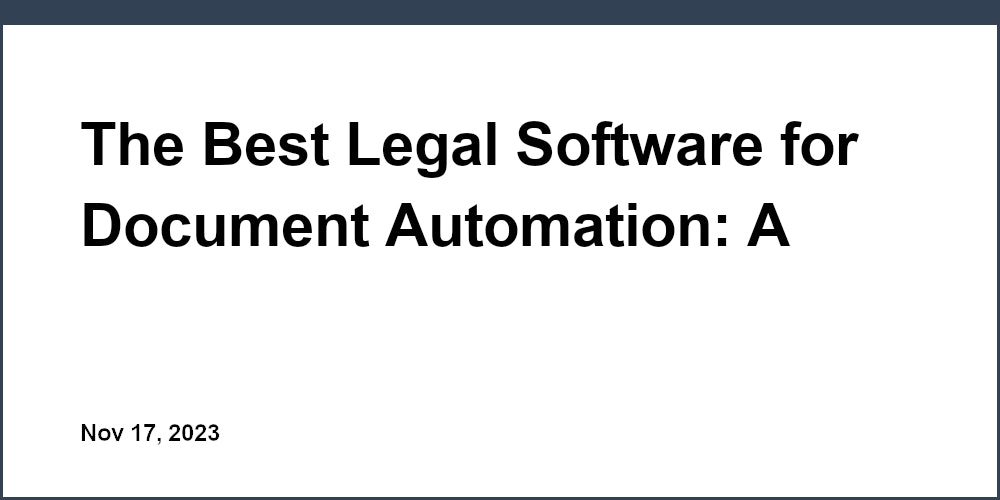Most legal professionals would agree that leveraging data and technology for litigation can be incredibly challenging.
However, new AI tools for predictive analysis are emerging that can provide litigation teams with enhanced insights and efficiency.
In this article, we'll define AI and its current role in the legal sector, discuss the advantages of using AI for litigation, highlight key tools for predictive analysis, and provide best practices for successfully implementing these technologies.
Introduction to AI in Litigation
Artificial intelligence (AI) is transforming how legal services are delivered. By leveraging predictive analytics and pattern recognition, AI tools can enhance efficiency and accuracy in litigation. This introductory section will provide an overview of AI's expanding role in the legal sector, current adoption trends, and the advantages AI solutions offer law firms and legal teams.
Defining AI and Its Role in the Legal Sector
AI refers to computer systems that can perform tasks normally requiring human intelligence, such as visual perception, decision-making, and language translation. In the legal industry, AI is being applied to automate repetitive tasks and reveal insights from large datasets.
Key applications of AI in litigation include:
-
Contract review: AI can rapidly scan contracts to extract key terms, identify risks, and highlight negotiating opportunities. This saves considerable time compared to manual review.
-
Predictive coding: By having lawyers tag a small subset of documents, AI can learn to predict document relevance for legal discovery. This minimizes the document review burden.
-
Legal research: AI tools can analyze case law more comprehensively than humans, identifying the most relevant precedents. This aids legal research and argument development.
-
Risk analysis: AI programs can ingest case details and judicial data to predict case outcomes and settlement values. This allows more informed litigation strategy and decisions.
As computing power and algorithm sophistication advances, AI will become integral to delivering cost-effective, high-quality legal services.
Current State of AI Adoption in Litigation
Across South America, AI adoption for litigation tasks is accelerating. Recent surveys indicate 22% of law firms currently use AI, with implementation expected to double in the next two years.
Early adopters have realized efficiency gains from applying AI for discovery and due diligence reviews. As familiarity grows, tools leveraging predictive analytics and data visualization will likely see increased usage.
However, barriers persist regarding integrating AI with case management systems, data quality, interpreting AI predictions, and talent acquisition. Law firms able to address these adoption challenges stand to gain a competitive edge.
Overall, AI is steadily transitioning from an emerging legal tech trend to an indispensable component of litigation practice. Law firms that fail to incorporate AI risk decreasing profit margins and diminishing client satisfaction.
Advantages of Leveraging AI for Litigation
Deploying AI solutions for litigation provides measurable benefits:
Enhanced predictive analysis
- More accurate case assessments and outcome forecasting
- Allows data-driven decisions on legal strategy
Improved process efficiency
- Faster document review turnaround
- Automates repetitive administrative tasks
Informed resource allocation
- Focus legal expertise on higher value-add activities
- Optimize teams and budgets based on case needs
Competitive differentiation
- Increased service quality and responsiveness
- Ability to take on more complex litigation
With the right implementation approach, AI systems can transform litigation performance while delivering significant return on investment.
Which AI is used for predictive analytics?
Predictive analytics leverages statistical modeling and machine learning algorithms to analyze current and historical data to make predictions about future outcomes. Some of the most common AI tools used for predictive analytics in legal services include:
IBM Watson
IBM Watson is an industry leader in enterprise AI, offering robust predictive analytics capabilities through services like Watson Discovery and Watson Explorer. These tools can analyze massive volumes of legal documents and case law to uncover insights and patterns to inform litigation strategy. For example, lawyers can leverage Watson's natural language processing to predict which arguments or defenses have the highest probability of success.
Lex Machina
Lex Machina applies AI and predictive analytics specifically for legal services. It provides insights from millions of legal cases to predict outcomes and opposing counsel behavior. Law firms use Lex Machina to anticipate judges’ likely decisions, trends in damages awards, and the best litigation strategies. With predictive insights, lawyers can pursue the highest value cases and craft winning legal arguments grounded in hard data.
Court Analytics
Court Analytics is a legal analytics platform combining AI, advanced analytics, and data visualization. It examines judge and court behavior to deliver predictive insights. Court Analytics can forecast how a particular judge may rule on motions, decide on certain damages, interpret the law, and more. These predictions allow lawyers to tailor case strategy for higher success rates.
By understanding historical data patterns and applying predictive algorithms, AI empowers lawyers to make data-driven decisions to strengthen case outcomes. AI tools like machine learning offer litigation teams a competitive edge through actionable insights for each stage of legal proceedings. With predictive analytics capabilities now accessible, lawyers can readily incorporate AI into their workflows for measurable gains.
Can AI predict legal outcomes?
With advances in artificial intelligence (AI), software tools are emerging that aim to analyze past legal cases and predict outcomes for new ones. One company at the forefront of this technology is LegalTech Company.
Founded by former Department of Justice trial attorney Dan Rabinowitz, LegalTech has developed an AI model that analyzes litigation data to predict how a judge might rule on a case. As reported by Axios, this system can now forecast judicial decisions with an accuracy of 86% - without even reviewing case facts.
Instead, the AI examines factors like the judge's history of rulings, the court's tendencies, and success rates of similar cases. By detecting subtle patterns across millions of legal documents, the algorithm provides attorneys data-driven insight to strengthen case strategy.
For example, the LegalTech software could indicate that Judge X has a track record of siding with plaintiffs in cases involving medical malpractice. This allows lawyers to set client expectations, tailor arguments more effectively, and better predict potential outcomes.
While AI cannot replace legal expertise and human judgment, tools like LegalTech's can uncover insights to complement an attorney's skills. This technology marks a promising step toward more evidence-based, probabilistic analysis in the legal domain.
With further development, AI-powered litigation prediction has the potential to boost efficiency, consistency, and transparency throughout the judicial process. However, appropriate oversight and governance frameworks will be key to ensuring such systems are deployed responsibly.
How to use AI for prediction?
Artificial intelligence (AI) tools can provide immense value in legal practice for predictive analysis. Here are some key ways law firms can leverage AI to enhance predictions:
Use historical case data
Feeding past case data into AI systems allows them to detect patterns and make predictions about the outcomes of future cases. Structured legal data from past case documents, such as briefs, complaints, motions and rulings can train predictive models effectively. Clean, well-labeled data leads to better predictions.
Choose the right AI approach
AI approaches like machine learning and deep learning are well-suited for predictions. While machine learning models can process structured data like documents and make predictions, deep learning models can also handle unstructured data like images and audio. Select the approach that aligns with your data type and prediction goals.
Integrate predictions into workflows
To fully realize the benefits of predictions, integrate them into daily workflows through user-friendly interfaces. Case management systems and litigation support software with built-in AI can surface predictions to attorneys in a simple and contextual manner during tasks like evidence review. This saves time and effort.
With thoughtful data preparation, model development and seamless integration into litigation workflows, law firms can tap into the immense potential of AI for enhancing legal predictive analytics. Reach out to Legal Buddies to learn how we can help you implement cutting-edge AI solutions tailored to your practice's needs!
sbb-itb-ba8dd7e
What is the difference between predictive analytics and generative AI?
Legal Buddy's Legal AI team often gets asked about the differences between predictive analytics and generative AI. As leaders in legal technology, we want to clarify these two important concepts.
Predictive analytics refers to using statistical models and machine learning algorithms to analyze historical data and make predictions about likely future outcomes. For example, we can analyze past legal case data to build a model that predicts the likelihood of a favorable verdict.
Generative AI is more cutting-edge. It uses neural networks to generate brand new content that is similar to data it has been trained on. For instance, Legal Buddy's generative AI can analyze thousands of legal briefs and then write an original brief with similar language and structure.
The key difference lies in their outputs. Predictive analytics provides probabilities and forecasts to support data-driven decisions. Generative AI creates novel content that mimics patterns in training data.
Both have incredible promise for streamlining legal work. Predictive analytics can forecast case trajectories to inform legal strategy. Meanwhile, generative AI like Legal Buddy's AI Writing Assistant can automate document drafting.
By leveraging both predictive insights and generative capabilities, legal teams can work smarter and faster. Let Legal Buddies partner with you to explore AI legal solutions tailored to your needs.
AI Tools for Enhanced Predictive Analysis
Artificial intelligence (AI) is transforming legal practices by enhancing predictive insights. As litigation becomes increasingly data-driven, AI tools offer advanced analytics to inform legal strategy and decision making. This section explores key technologies that legal teams can leverage to improve predictive capabilities.
Predictive Coding for Discovery and Due Diligence
E-discovery requires sifting through expansive document sets to identify relevant information. Manual review is tedious, time-consuming, and prone to human error. Predictive coding streamlines this process by using machine learning algorithms to classify documents based on relevancy and responsiveness.
Legal teams upload a small, representative sample of documents which are then coded by attorneys. The algorithm learns from these examples to predict how the remaining documents should be classified. As more documents are coded, the system continuously improves its accuracy through active machine learning. This reduces the document review burden on legal staff while accelerating insights.
Predictive coding enables more decisive early case assessments by quickly surfacing pivotal evidence. It also mitigates discovery risks as the technology can rapidly search enormous datasets of unstructured data. Predictive coding has demonstrated up to 90% accuracy in identifying responsive documents. This transforms document review from a speculative fishing expedition to a targeted, insightful process guided by data.
Legal Analytics for Data-Driven Insights
Legal analytics leverage vast stores of case data to reveal trends and patterns that inform litigation strategy. Analytics solutions aggregate verdicts, settlements, judgesâ€TM histories, and success rates of legal arguments across jurisdictions. Attorneys can query this data to benchmark case values or determine the optimal venues, claims and defenses to pursue.
Lex Machina provides analytics across intellectual property, antitrust, commercial, securities, and employment law cases. Attorneys can filter data by specific courts, judges, lawyers, law firms, and parties to uncover granular insights. These enhance understanding of what strategies and arguments have historically worked. Analytics are also useful for projecting legal budgets and matter timelines.
By basing litigation approaches on hard data rather than intuition, legal teams gain an analytical edge. Analytics enhance the accuracy of risk assessments and predictions for case trajectories and outcomes. This allows for better-informed settlements and mitigation strategies.
AI for Calculation of Damages
Determining appropriate damage claims relies heavily on legal judgment and subjectivity. AI solutions are emerging to add more precision and consistency in award value projections.
CaseCrunch Analytics uses a vault of millions of historical cases to benchmark damages across different injury types. Users input details of the case and injury. Algorithms then cross-reference this data against comparable precedents to generate a damages estimate. This analysis accounts for how different judges and juries have assessed injuries of similar severity.
Lex Machina also released a Legal Damages Explorer which considers past median damages and settlements. Attorneys can filter the supporting case data by jurisdiction, court level, judge, timing, and other factors. This enhances context for more accurate award value forecasting.
Incorporating legal analytics enables projections to be grounded in real-world data points versus hypotheticals. It brings enhanced accuracy and speed to quantifying damages early in litigation. More precise estimates inform settlement discussions and strategy.
Best Practices for Implementation
Here we provide practical guidance on integrating AI tools into existing legal workflows for maximum impact.
Assessing Current Workflows and Data Infrastructure
When preparing to implement AI systems for litigation, conducting an in-depth evaluation of current workflows and available data is an essential first step. This allows organizations to identify areas that can benefit most from automation and analytics. Key activities in this assessment phase include:
- Mapping out all litigation processes end-to-end, documenting tasks, data sources, bottlenecks, and pain points
- Auditing existing case data and documents to gauge quality, consistency and accessibility of information
- Determining availability of labeled training datasets which are vital for developing accurate AI prediction models
- Pinpointing litigation tasks involving repetitive information processing that can be fully or partially automated
- Identifying areas of subjectivity and complexity still requiring human legal expertise
Proper workflow and data evaluation enables organizations to devise customized AI adoption roadmaps aligned to their specific needs. It also helps assemble high-quality training datasets targeting the right legal use cases.
Selecting the Right AI Tools and Partners
With litigation workflows and data infrastructure assessed, next organizations must identify and carefully evaluate AI vendor solutions. Key selection criteria include:
- Proven accuracy - Assess predictive precision on real legal cases using confusion matrices and other standard AI model evaluation techniques
- Explainability - Choose transparent AI models whose predictions can be easily interpreted and justified
- Data security - Vet security protocols, access controls and data encryption measures
- Customizability - Opt for platforms allowing easy retraining of models on new data
- Ease of integration - Ensure tools seamlessly connect with existing software stacks via APIs
- Scalability - Pick cloud-based solutions that can expand as litigation caseloads grow
- Compliance - Confirm vendor offerings meet all ethical AI standards and industry regulations
- Vendor support - Partner with AI providers offering full customer implementation guidance and training
Taking the time to thoroughly assess solutions against these criteria reduces technology risk and ensures optimal ROI.
Change Management Considerations
The infusion of new AI capabilities into litigation workflows requires adjustments to processes, culture and employee mindsets. Proactive change management is key to driving adoption and extracting full value from AI systems. Important focus areas include:
- Stakeholder alignment - Engage leadership, IT, legal teams and other groups early to set objectives, mitigate concerns and secure buy-in
- Phased rollouts - Introduce AI tools incrementally via small pilot projects to build confidence and gather feedback
- Training programs - Offer hands-on education to Users on AI system functionalities, use cases and decision outputs
- Job impact evaluation - Continuously assess emerging workflow changes and plan skills development for most affected roles
- Communication plan - Provide regular updates showcasing AI benefits and addressing questions from affected employees
With inclusive planning centered on user needs, organizations can smoothly transition workforces to leverage AI and unlock enhanced efficiency and insights.
The Future of AI in Litigation
Legal technology and AI-powered solutions are rapidly transforming the practice of law. As these innovations continue maturing, law firms who fail to embrace them risk compromising their competitive edge. However, thoughtfully integrating the right solutions can significantly enhance efficiency and outcomes for clients.
Accelerated Adoption Across Legal Sector
Multiple socio-political and technological trends are accelerating AI adoption in the legal industry:
- Investments in legal tech startups have grown exponentially as VCs bet on AI's transformative potential in law. Governments are also boosting funding for AI research. These trends will likely intensify innovation.
- Demand for affordable legal services is rising while clients expect better outcomes. AI tools that enhance productivity and accuracy can help meet these dual needs.
- New laws like the EU's proposed AI Act will likely spur investments in trustworthy, ethical AI solutions for litigation and other legal tasks.
As these drivers converge, AI looks set to rapidly permeate litigation and other legal services.
Specialization of AI Tools for Litigation
Rather than generic software, purpose-built AI solutions for litigation tasks will emerge:
- Contract review, e-discovery, legal research/predictions, and document automation are already seeing specialized AI tools. This trend will accelerate.
- As data volumes grow, AI's pattern spotting abilities will help uncover insights humans could miss, aiding decisions.
- Natural language solutions will enhance document search, review, summarizations and more to boost productivity.
Such litigation-focused applications will minimize manual work so legal teams can concentrate on high-value tasks.
Pressure to Embrace AI or Risk Irrelevance
Firms who fail to thoughtfully integrate AI and modern technology risk compromising competitiveness:
- Data and predictions will underpin legal services. Teams without access to AI insights may struggle to keep pace.
- Automating repetitive tasks allows focus on complex problem solving, strategy and client needs - areas where human skills matter most.
- AI productivity tools will increasingly become table stakes. Using them judiciously will be key.
Rather than resisting change, the wise course is to embrace AI's potential - with care and responsibility. Prioritizing client outcomes and equitable access, firms can transform services while upholding ethics and social good.


